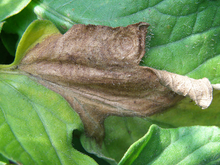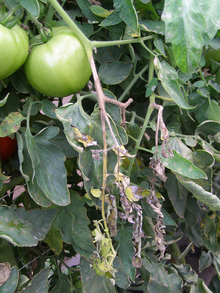Quick facts
- Gray mold thrives in the high humidity found in high tunnel and greenhouse tomato production.
- Gray mold is rare in Minnesota field grown tomatoes.
- The fungal pathogen infects all above ground plant parts.
- It can be highly destructive when environmental conditions favor disease.
How to tell gray mold apart from other issue
- Gray mold occurs in cool temperatures (between 60-75°F) and high humidity (greater than 80%)
- In high humidity, fluffy gray spores cover infected plant parts.
- Leaves have irregular to V-shaped brown blotches, often starting at the margin of the leaf.
- Die-back symptoms appear as infection progresses from leaves, through petioles, towards the main stem.
- Brown, oval lesions can girdle the stem.
- Infected flowers turn brown and die.
- The spores are light brown-gray on black stalks.
- Infected fruit develop a pale, soft, watery rot, or have white rings or halos on the fruit, called ghost spots.
- Fruit symptoms occur on green and red fruit; while on the plant and post-harvest.
Biology
- Gray mold is caused by the fungus Botrytis cinerea
- Disease develops in temperatures between 60-75°F (60-70°F optimum). Temperatures greater than 82°F suppress fungal growth and sporulation.
- Gray mold requires high humidity (greater than 80%).
- Spores are most likely to germinate when leaves remain wet for 5-8 hours.
- The fungus survives on numerous weed hosts, on dead plant material, and as hard resting structures (sclerotia) in plant debris and soil.
- Spores are spread short and long distances by wind and rain, equipment and workers.
- Infections begin on weak, dying or wounded plant tissue.
Managing Gray Mold in Home Gardens
Because of the high humidity requirements of gray mold, this disease is unlikely to be seen in home gardens. For a list of more likely candidates, see the U of M’s “Quick Guide to Insects and Disease of Tomato.”
Managing Gray Mold on Farms
There are no tomato varieties with resistance to gray mold.
- Keep humidity and leaf wetness low by rolling up high tunnel sides, increasing ventilation and avoiding overhead irrigation.
- Space plants well to avoid excess humidity in dense plant canopies. Putting 20-24 inches between plants and 4 to 5 feet between rows is a good place to start.
- Remove infected stems, leaves and fruit. Place in a plastic bag.
- Clean up leaf debris on the ground.
- Prune plants in the afternoon when the morning dew has dried.
- Remove all plant debris at the end of the season.
- Maintain consistent and adequate soil moisture to promote healthy plants and fruit.
- Make sure soil has adequate calcium so growing plants produce healthy tissue.
- Fungicides are available for control of gray mold on tomato.
- They should only be used once cultural practices have been implemented.
- Apply fungicide according to label instructions.
- Fungicide-resistant gray mold has been reported on many crops.
- Rotate fungicide groups and/or tank mix fungicides to avoid producing fungicide-resistant isolates.
- For a current list of fungicides for gray mold management see the Midwest Vegetable Production Guide
CAUTION: Mention of a pesticide or use of a pesticide label is for educational purposes only. Always follow the pesticide label directions attached to the pesticide container you are using. Be sure that the plant you wish to treat is listed on the label of the pesticide you intend to use. And observe the number of days between pesticide application and when you can harvest your crop. Remember, the label is the law.
Reviewed in 2021





